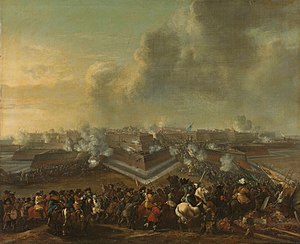สงครามฝรั่งเศส-เนเธอร์แลนด์
สงครามฝรั่งเศส-เนเธอร์แลนด์ ระหว่าง ค.ศ. 1672 ถึง 1678 หรือรู้จักกันในนาม สงครามดัชต์, (ฝรั่งเศส: Guerre de Hollande; ดัตช์: Hollandse Oorlog) เป็นสงครามที่มีฝรั่งเศสและสาธารณรัฐดัตช์ เป็นคู่ขัดแย้งหลัก โดยมีจักรวรรดิโรมันอันศักดิ์สิทธิ์ สเปน บรันเดินบวร์ค-ปรัสเซีย และเดนมาร์ก–นอร์เวย์เป็นผู้ร่วมรบด้วย พันธมิตรฝ่ายฝรั่งเศสประกอบด้วย ราชรัฐอัครมุขนายกมึนส์เทอร์ รัฐผู้คัดเลือกโคโลญ ซึ่งถอนตัวออกไปใน ค.ศ. 1673 และราชอาณาจักรอังกฤษ ซึ่งถอนตัวออกจากสงครามในอีกหนึ่งปีให้หลัง ก่อนที่จะกลับมาเข้าร่วมใหม่ในเดือนกุมภาพันธ์ ค.ศ. 1678 ในฐานะพันธมิตรของเนเธอร์แลนด์
| สงครามฝรั่งเศส-เนเธอร์แลนด์ | |||||||||
|---|---|---|---|---|---|---|---|---|---|
 ภาพวาดการเข้ายึดเมืองกูฟอร์เดิน (Coevorden) โดยทหารดัชต์ภายใต้การบังคับบัญชาของคาร์ล ฟ็อน ราเบนแฮ็ปพ์ ในเดือนธันวาคม ค.ศ. 1672 | |||||||||
| |||||||||
| คู่สงคราม | |||||||||
|
| ||||||||
| ผู้บังคับบัญชาและผู้นำ | |||||||||
| กำลัง | |||||||||
|
|
| ||||||||
| ความสูญเสีย | |||||||||
| เสียชีวิตและบาดเจ็บ 120,000 นาย [1] | เสียชีวิตและบาดเจ็บ 100,000 นาย [1] | ||||||||
สงครามเริ่มดุเดือดขึ้นในเดือนพฤษภาคม ค.ศ. 1672 เมื่อฝ่ายฝรั่งเศสสามารถบดขยี้กองกำลังของสาธารณรัฐดัตช์ได้เกือบทั้งหมด ซึ่งในภายหลัง เหตุการณ์นี้กลายมาเป็นที่รู้จักกันในชื่อ รัมยาลล์ (Rampjaar) หรือ "ปีมหาวิบัติ"[2] การรุกคืบของฝรั่งเศสมาหยุดชะงักลงที่แนวแม่น้ำไอเซล (IJssel) ในเดือนมิถุนายน และเมื่อถึงปลายเดือนกรกฎาคม ฝ่ายดัชต์ก็สามารถกลับมาตั้งหลักได้อีกครั้ง ความกังวลถึงผลเสียที่จะตามมาหากฝรั่งเศสเป็นฝ่ายชนะสงครามนำไปสู่การลงนามพันธมิตรทางทหารระหว่างเนเธอร์แลนด์ จักรพรรดิเลโอพ็อลท์ที่ 1 สเปน และบรันเดินบวร์ค-ปรัสเซีย ในเดือนสิงหาคม ค.ศ. 1683 โดยมีดัชชีลอแรนและเดนมาร์ก–นอร์เวย์เข้าร่วมด้วยในภายหลัง ในขณะที่อังกฤษลงนามสงบศึกและถอนตัวออกไปในเดือนกุมภาพันธ์ ค.ศ. 1674 เมื่อฝ่ายฝรั่งเศสเห็นว่าตนกำลังเผชิญสงครามหลายแนวรบจึงถอนกำลังออกจากสาธารณรัฐดัตช์ และคงกำลังไว้ในเมืองกราฟ (Grave) และมาสทริชท์ เท่านั้น
เมื่อเห็นดังนั้นพระเจ้าหลุยส์ที่ 14 จึงทรงเบนเป้าหมายไปยังเนเธอร์แลนด์ของสเปนและไรน์ลันท์ ในขณะที่ฝ่ายสัมพันธมิตรซึ่งนำโดยเจ้าชายวิลเลมแห่งออเรนจ์ ต้องการจำกัดการตักตวงผลประโยชน์ทางดินแดนของฝรั่งเศสจากสงครามครั้งนี้ หลังจากค.ศ. 1674 ฝรั่งเศสได้เข้ายึดครองแคว้นฟร็องช์-กงเต และพื้นที่ตามแนวชายแดนที่ติดกับเนเธอร์แลนด์ของสเปน รวมไปถึงแคว้นอาลซัส แต่ก็ไม่มีฝ่ายใดสามารถเอาชนะกันได้อย่างเด็ดขาด สงครามมายุติลงในเดือนกันยายน ค.ศ. 1678 ด้วยการลงนามในสนธิสัญญาสันติภาพไนเมเคิน ถึงแม้เงื่อนไขในสนธิสัญญาดังกล่าวจะให้ผลประโยชน์น้อยกว่าข้อเสนอสงบศึกในเดือนมิถุนายน ค.ศ. 1672 แต่ก็ถือกันว่าสงครามครั้งนี้เป็นจุดสูงสุดของความสำเร็จทางด้านการทหารในรัชสมัยของพระเจ้าหลุยส์ที่ 14 และส่งผลให้การโฆษณาชวนเชื่อของพระองค์ประสบความสำเร็จอย่างมีนัยยะสำคัญ
สเปนได้เมืองชาร์เลอรัว คืนจากฝรั่งเศส แลกกับการมอบแคว้นแคว้นฟร็องช์-กงเต รวมไปพื้นที่ส่วนใหญ่ของอาร์ตัวและแอโน ก่อให้เกิดแนวพรมแดนที่ค่อนข้างคล้ายคลึงกับในปัจจุบัน การได้มาสทริชท์กลับคืนมาหมายความว่าเนเธอร์แลนด์ได้พื้นที่ที่เสียไปในช่วงต้นสงครามกลับคืนมาทั้งหมด ความสำเร็จดังกล่าวส่งผลให้อิทธิพลของเจ้าชายวิลเลมแห่งออเรนจ์มีบทบาทเด่นในกิจการภายในของสาธารณรัฐดัตช์ ซึ่งช่วยให้พระองค์สามารถต้านทานภัยคุกคามจากการขยายดินแดนของฝรั่งเศส และนำไปสู่การก่อตั้งมหาพันธมิตร ซึ่งต่อสู้ในสงครามเก้าปี
อ้างอิง
แก้- ↑ 1.0 1.1 1.2 1.3 Clodfelter 1992, p. 47.
- ↑ 1672 Disaster Year เก็บถาวร 24 เมษายน 2016 ที่ เวย์แบ็กแมชชีน, ริกส์มิวเซียม
บรรณานุกรม
แก้- Barton, Simon (2008). A History of Spain. Palgrave. ISBN 978-0230200128.
- Black, Jeremy (2011). Beyond the Military Revolution: War in the Seventeenth Century World. Palgrave Macmillan. ISBN 978-0230251564.
- Blackmore, RT (2011). Warfare on the Mediterranean in the Age of Sail: A History, 1571–1866. McFarland & Co. ISBN 978-0786447992.
- Boxer, CR (1969). "Some Second Thoughts on the Third Anglo-Dutch War, 1672–1674". Transactions of the Royal Historical Society. 19: 67–94. doi:10.2307/3678740. JSTOR 3678740.
- Clark, Christopher M. (2007). Iron kingdom: the rise and downfall of Prussia, 1600–1947. Penguin. ISBN 978-0140293340.
- Childs, John (1991). The Nine Years' War and the British Army, 1688–1697: The Operations in the Low Countries. Manchester University Press. ISBN 978-0719089961.
- Clodfelter, Michael (1992). Warfare and Armed Conflicts: A Statistical Reference to Casualty and Other Figures, 1500–2000. McFarland & Co. ISBN 978-0786474707.
- Frost, Robert (2000). The Northern Wars; State and Society in Northeastern Europe 1558–1721. Routledge. ISBN 978-0582064294.
- Geyl, P (1936). "Johan de Witt, Grand Pensionary of Holland, 1653–72". History. 20 (80): 303–319. doi:10.1111/j.1468-229X.1936.tb00103.x. JSTOR 24401084.
- Hutton, Ronald (1989). Charles II: King of England, Scotland and Ireland. Clarendon Press. ISBN 978-0198229117.
- Hutton, R (1986). "The Making of the Secret Treaty of Dover, 1668–1670". The Historical Journal. 29 (2): 297–318. doi:10.1017/S0018246X00018756. JSTOR 2639064.
- Israel, Jonathan (1990). Dutch Primacy in World Trade, 1585–1740 (1990 ed.). Oxford University Press. ISBN 978-0198211396.
- Jacques, Tony (2007). Dictionary of Battles and Sieges: A Guide to 8,500 Battles from Antiquity through the Twenty-first Century, Volume 2, F–O. Greenwood. ISBN 978-0313335389.
- Kenyon, JP (1986). The History Men: The Historical Profession in England since the Renaissance (1993 ed.). Weidenfeld & Nicolson.
- Linklater, Magnus (2004). "Graham, John, first viscount of Dundee [known as Bonnie Dundee]". Oxford Dictionary of National Biography (online ed.). Oxford University Press. doi:10.1093/ref:odnb/11208. (ต้องรับบริการหรือเป็นสมาชิกหอสมุดสาธารณะสหราชอาณาจักร)
- Lynn, John (1999). The Wars of Louis XIV, 1667–1714 (Modern Wars in Perspective). Longman. ISBN 978-0582056299.
- Nolan, Cathal (2008). Wars of the Age of Louis XIV, 1650–1715: An Encyclopedia of Global Warfare and Civilization. Greenwood. ISBN 978-0313330469.
- Palmer, Michael (2005). Command at Sea: Naval Command and Control Since the Sixteenth Century. Harvard University Press. ISBN 978-0674024113.
- Panhuysen, Luc (2009). Rampjaar 1672: Hoe de Republiek aan de ondergang ontsnapte. Uitgeverij Atlas. ISBN 9789045013282.
- Panhuysen, Luc (2016). Oranje tegen de Zonnekoning: De strijd van Willem III en Lodewijk XIV om Europa. De Arbeiderspers. ISBN 978-9029538718.
- Reinders, Michel (2013). Printed Pandemonium: Popular Print and Politics in the Netherlands 1650–72. Brill. ISBN 978-9004243187.
- Rowen, Henry Herbert (1978). John de Witt, Grand Pensionary of Holland, 1625–1672 (2015 ed.). Princeton University Press. ISBN 978-0691600437.
- Rowen, Herbert H (1954). "John De Witt and the Triple Alliance". The Journal of Modern History. 26 (1): 1–14. doi:10.1086/237659. JSTOR 1874869. S2CID 145695238.
- Satterfield, George (2003). Princes, Posts and Partisans: The Army of Louis XIV and Partisan Warfare in the Netherlands (1673–1678). Brill. ISBN 978-9004131767.
- Sommerville, J. P. (16 January 2008), The wars of Louis XIV
- Smith, Rhea Marsh (1965). Spain: A Modern History. Ann Arbor, Michigan: University of Michigan Press. OCLC 733708764.
- Starkey, Armstrong (2003). War in the Age of Enlightenment, 1700–1789. Praeger. ISBN 978-0275972400.
- Troost, W. (2001). Stadhouder-koning Willem III: Een politieke biografie. Hilversum: Uitgeverij Verloren. ISBN 90-6550-639-X.
- Tucker, Spencer C. (2009-12-23). A Global Chronology of Conflict: From the Ancient World to the Modern Middle East [6 volumes]: From the Ancient World to the Modern Middle East. ABC-CLIO. ISBN 978-1-85109-672-5.
- Van Nimwegen, Olaf (2010). The Dutch Army and the Military Revolutions, 1588–1688. Boydell Press. ISBN 978-1843835752.
- Wolf, John (1962). The Emergence of European Civilization. Joanna Cotler Books. ISBN 978-0060471804.
- Wolfe, Michael (2009). Walled Towns and the Shaping of France: From the Medieval to the Early Modern Era. AIAA. ISBN 978-0230608122.
- Young, William (2004). International Politics and Warfare in the Age of Louis XIV and Peter the Great. iUniverse. ISBN 978-0595329922.